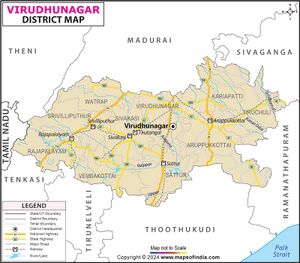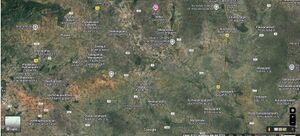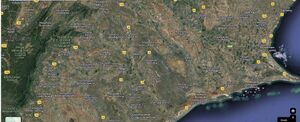Sivakasi
| Author:Laxman Burdak, IFS (R) |



Sivakasi (शिवकाशी) is a city and taluka in Virudhunagar District in the Indian state of Tamil Nadu. It is located on Ram Van Gaman Path.
Variants
- Shivakasi (शिवकाशी)
Location
Sivakasi is located at 9.45°N 77.8167°E and has an average elevation of 101 metres (331 feet). The city is located in Virudhunagar district of the South Indian state, Tamil Nadu, at a distance of 74 km from Madurai. Sivakasi is located to the east of Western Ghats and to the west of Sattur.
Sivakasi is a Town in Sivakasi Block in Virudhunagar District of Tamil Nadu State, India. It is located 22 KM towards west from District head quarters Virudhunagar. It is a Block head quarter. Sivakasi Pin code is 626123 and postal head office is Sivakasi. Vadapatti ( 1 KM ) , Vivekananda Colony Kamarajapuram Colony ( 1 KM ) , Bharathi Nagar ( 1 KM ) , Vivekananda Colony Parasakthi Colony ( 1 KM ) , Kaliappa Nagar ( 1 KM ) are the nearby Villages to Sivakasi. Sivakasi is surrounded by Vembakottai Block towards South , Sattur Block towards South , Srivilliputtur Block towards west , Virudhunagar Block towards East.[1]
History
Sivakasi was established during the early 15th century CE. Between 1428 and 1460, a Pandya king Harikesari Parakkirama Pandian ruled the southern part of Madurai region (comprising modern-day Sivakasi and its surroundings). Hindu legend relates that he wanted to construct a temple for the Hindu god Shiva at Tenkasi and went to Kasi to bring a lingam (an iconic representation of Shiva). While returning to his palace with the prized lingam, he rested under the grove of a vilva tree, the favourite tree of Shiva. When a cow carrying the lingam refused to move from the spot, the king realised that the wishes of Shiva were different from his own, and he placed the lingam in the place where the cow halted. The place where the "Shiva lingam brought from Kasi" was installed came to be known as Sivakasi.[2][3] Sivakasi was a part of the Madurai region during the 16th century. Madurai became independent from the Vijayanagar Empire in 1559 under the Nayaks.[4] Nayak rule ended in 1736 and Madurai was repeatedly captured several times by Chanda Sahib (1740–1754), Arcot Nawab and Muhammed Yusuf Khan (1725–1764) in the middle of the 18th century.[5] In 1801, Madurai came under the direct control of the British East India Company and was annexed to the Madras Presidency.[6]
The mutual confrontation between the Maravars and Nadars reached its peak in 1899, leading to a series of riots which became known as the Sivakasi riots. A total of 22 people were killed, as many as 800 houses and the Big Chariot in the center of the city (used by the temple during festivals) were burnt during the riots. Eventually, the riots came to an end after the intervention of the military in mid-July 1899.[7]
Geography
The topography is almost plain, with no major geological formation. There are no notable mineral resources available in and around the city. The soil types are black and red that are conducive to cotton, chillies, and millets. These crops are predominant because of poor groundwater supply and soil type. Sivakasi experiences hot and dry weather throughout the year. The temperature ranges from a maximum of 39 °C (102 °F) to a minimum of 23 °C (73 °F). Like the rest of the state, April to June are the hottest months and December to January are the coldest. Sivakasi receives scanty rainfall with an average of 812 mm (32.0 in) annually, which is lesser than the state average of 1,008 mm (39.7 in). The Southwest monsoon, with an onset in June and lasting up to August, brings scanty rainfall. The bulk of the rainfall is received during the North East monsoon in the months of October, November and December.
Economy
The city is known for firecrackers and match factories that produce 70% of the country's output. The printing industries in Sivakasi produce 30% of the total diaries produced in India. The industries in Sivakasi employ over 25,000 people and the estimated turnover of the firecracker, match making and printing industries in the city is around ₹20 billion (US$230 million). The major issues in the city are the frequent accidents in the firecracker factories and the high level of child labour.
Sivakasi has a dry weather, making it suitable for dry crops like cotton, chillies and millets. Bhadrakali Amman temple is the most prominent landmark of Sivakasi, and the temple festivals constitute the major festivals of the city.
External links
References
- ↑ http://www.onefivenine.com/india/villages/Virudhunagar/Sivakasi/Sivakasi#google_vignette
- ↑ "Sivakasi History". Sivakasi Municipality. 2011.
- ↑ Subramaniam, Neela. Om Namah Shivaya. Chennai: Young Kids Press. p. 4. ISBN 81-7478-510-8
- ↑ V., Vriddhagirisan (1995) [1942], Nayaks of Tanjore, New Delhi: Asian Educational Services, p. 115, ISBN 81-206-0996-4
- ↑ Harman, William. P (1992). The sacred marriage of a Hindu goddess. Motilal Banarsidass. pp. 30–36. ISBN 978-81-208-0810-2.
- ↑ Markovits, Claude (2004), A History of Modern India, 1480–1950, London: Wimbledon Publishing Company, p. 253, ISBN 1-84331-152-6,
- ↑ Hardgrave, Robert (1969). The Nadars of Tamil Nadu. University of California Press. p. 118.

